
Plant-Based Eating Evolves
Driven by growing consumer passion for wellness and sustainability, the market for vegan and other vegetarian products is expanding rapidly, and product developers are responding with an array of new product options.
Article Content
A vegan for nearly 30 years, Miyoko Schinner has a deep understanding of the evolution of the plant-based food movement. Her personal journey—which began with the discovery of her lactose intolerance and grew into a passion for animal welfare and conviction that veganism is better for the environment—parallels the crescendoing interest in animal product alternatives in the United States today.
A 2016 Harris Poll survey sponsored by Baltimore-based Vegetarian Resource Group (VRG) indicates that even though just 3.3% of the U.S. population is vegetarian, with roughly half of these individuals strict vegans, 37% of Americans sometimes order vegetarian food when eating out (VRG 2016). Similarly, a 2015 survey commissioned by VRG showed that 36% of respondents ate vegetarian meals at least once a week (VRG 2015).
Schinner, the author of several vegan cookbooks and founder of Fairfax, Calif.–based Miyoko’s Kitchen, predicts that the percentage of people who forgo meat and dairy products at least periodically will grow ever-larger. She notes that her vegan cheesemaking firm has seen sales increase by approximately 300% annually over the past few years, requiring her to build a new production facility more than five times the size of her original site.
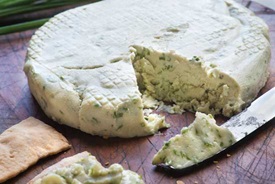 “Vegans are not the only people who buy our cheese,” says Schinner, whose cheese alternatives and spreads are made from fermented cashews. “At this point, I would say that most of the people who buy our cheese are flexitarians. They are in that realm of people who are exploring other options outside of traditional meat and dairy because it’s healthier, better for the environment, and better for animals, but they are not 100% committed.”
“Vegans are not the only people who buy our cheese,” says Schinner, whose cheese alternatives and spreads are made from fermented cashews. “At this point, I would say that most of the people who buy our cheese are flexitarians. They are in that realm of people who are exploring other options outside of traditional meat and dairy because it’s healthier, better for the environment, and better for animals, but they are not 100% committed.”
Flexitarians range from those who indulge in animal-based food only occasionally, such as former President Bill Clinton, previously a steadfast vegan due to cardiovascular disease, to those who are striving to reduce their substantial meat and dairy consumption despite temptation (Packaged Facts 2016). Their numbers have been bolstered in recent years by the intensifying, now global Meatless Monday campaign, originally a World War I rationing initiative in the United States, which health advocate Sid Lerner revived in 2003 in association with the Johns Hopkins Bloomberg School of Public Health’s Center for a Livable Future (Meatless Monday 2017).
Many flexitarians are Baby Boomers, influenced by such research as a 2014 study in the American Journal of Epidemiology linking high red meat consumption, especially processed meat, to “all-cause mortality” (Packaged Facts 2016). But the Millennial generation is much more likely to eschew animal products. A study by Bellevue, Wash.–based The Hartman Group conducted a few years ago found that 12% of Millennials are “faithful vegetarians” in contrast to 4% of Generation Xers and 1% of Baby Boomers (Tanenhaus 2014). What’s more, 60% of Millennials consume meat alternatives, revealed a 2015 study by San Antonio, Texas–based 210 Analytics (Packaged Facts 2016).
Reflecting these trends, U.S. retail sales of plant-based foods and beverages increased 3.4% to $4.9 billion in the 52 weeks ending June 12, 2016, reported Chicago-based market research firm SPINS. Retail sales of cheese alternatives grew 11%, while refrigerated and frozen meat alternatives grew 8% and 2.7%, respectively (SPINS 2016).
Globally, demand for vegetarian, especially vegan, products and restaurant meals continues to climb. “Sales of plant-based meat substitutes have made steady gains in developed markets,” says Marissa Bosler, a Chicago-based communications executive with Euromonitor International. In Germany, for example, meat substitutes have been experiencing double-digit sales growth while meat consumption is declining (Schoon 2015).
Arnhem, The Netherlands–based Innova Market Insights reported a 24% compound annual growth rate in meat substitute launches worldwide between 2011 and 2015 (Innova 2016).
Indeed, concerned that more than 70% of the world’s animal products come from factory farms, the Farm Animal Investment Risk & Return (FAIRR) network, founded by Jeremy Coller of Coller Capital, has raised more than $1 trillion from investors who are betting on the future of a plant-based food supply.
The favorable statistics and abundance of available funding dollars have created a fertile landscape for research and development, with more and more entrepreneurs and established food companies rolling out vegan meals, snacks, and other products.
“It’s huge,” says Kara Nielsen, an Oakland, Calif.-based food trend analyst. “We’re seeing a real surge of innovative, global-flavored plant-based products and meal solutions.”
The innovation, according to Nielsen, can be divided into two camps: the development of meat, seafood, and dairy substitutes and the creation of new products that showcase the inherent flavors, textures, and nutrients of plant-derived foods.
Mimicking Meat, Seafood, Mayo
One nascent trend Nielsen has observed is the use of young jackfruit as a meat substitute because its texture resembles that of pulled pork. “Though jackfruit is consumed in Southeast Asian countries, this is a really new and innovative product for the American market,” she says.
With roughly 2 grams of protein per serving, jackfruit is relatively high in protein for a fruit but not comparable in protein to other meat alternatives. Still, high in fiber, potassium, and other nutrients and featuring a naturally stringy texture, jackfruit enables the creation of a clean label and healthful meat analogue, notes Daniel Staackmann, founder and president of Chicago-based Upton’s Naturals. In contrast to meat substitutes that are highly processed, “our goal is to make products with as simple ingredients as possible; so the jackfruit is literally just jackfruit,” he says.
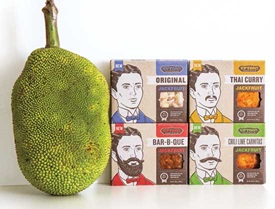 Upton’s Naturals makes four shelf-stable jackfruit main dishes that, Staackmann suggests, can be paired with beans or another protein source for a more balanced meal: Bar-B-Que, Chili Lime Carnitas, Thai Curry, and Original.
Upton’s Naturals makes four shelf-stable jackfruit main dishes that, Staackmann suggests, can be paired with beans or another protein source for a more balanced meal: Bar-B-Que, Chili Lime Carnitas, Thai Curry, and Original.
Upton’s Naturals sources its jackfruit, the largest tree-borne fruit in the world, from Thailand, which is where production takes place. While mature jackfruit, weighing up to 100 pounds, are eaten raw and have a flavor “like a mix between mango, banana, and pineapple,” according to Staackmann, only young jackfruit have the meat-like texture that his products require. Prioritizing sustainability, his company uses jackfruit that Thai farmers cull in their quest to develop prized mature jackfruit.
Meanwhile, Annie Ryu decided to found Boston-based The Jackfruit Company as a Harvard University premedical student working on a health project in rural southern India. “On my first day, I saw this big, green, spiky thing lying on the street and learned it was a jackfruit,” she remembers. “And when I first tasted jackfruit, I thought it tasted incredible.”
In India, jackfruit is abundant, but most of it goes to waste, Ryu says. She started her company in large part to help Indian farmers earn a livelihood from this “delicious, nutritious crop that is drought-resistant and naturally organic and has incredibly high yields.”
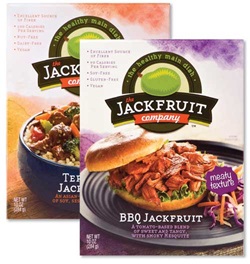 The Jackfruit Company offers three products: BBQ Jackfruit (a tomato-based blend of sweet and tangy with smoky mesquite), Tex-Mex Jackfruit (savory southwestern flavor with notes of cumin and oregano), and Teriyaki Jackfruit (an Asian-inspired bend of soy, sesame, and ginger).
The Jackfruit Company offers three products: BBQ Jackfruit (a tomato-based blend of sweet and tangy with smoky mesquite), Tex-Mex Jackfruit (savory southwestern flavor with notes of cumin and oregano), and Teriyaki Jackfruit (an Asian-inspired bend of soy, sesame, and ginger).
Veggie burgers, however, have drawn the most investment interest, as established food companies, start-ups, and university researchers strive to replicate America’s favorite food: the juicy hamburger.
Springdale, Ark.–headquartered Tyson Foods now owns a 5% stake in El Segundo, Calif.–based Beyond Meat Co., a privately held producer of meat alternatives, including its latest product—the Beyond Burger. Each with 20 grams of protein derived primarily from peas, these plant-based burger patties are soy-free and GMO-free and are intended to be sold in supermarket meat cases (Beyond Meat 2016).
“We’re enthusiastic about this investment, which gives us exposure to a fast-growing segment of the protein market,” Monica McGurk, Tyson’s executive vice president of strategy and new ventures, said in a statement in October 2016. Ethan Brown, the founder and CEO of Beyond Meat, has also secured funding from Bill Gates, The Humane Society of the United States, and General Mills’ 301 Inc. venture capital arm, among other investors (Tanenhaus 2016).
Beyond Meat uses beets to impart a natural red color to the Beyond Burger patties, which turn brown and sizzle during the cooking process, simulating the experience of cooking beef. “Our belief is that the best way to get people to eat less meat is by giving them what they love—in this case, a juicy, delicious burger—without the health, sustainability, and animal welfare downside of an animal-based burger,” the company states on its website (Beyond Meat 2016).
Another meat-alternative venture, backed by more than $80 million in funding, is Redwood City, Calif.-based Impossible Foods. Founded in 2009 by biochemist and vegan Patrick O. Brown, a Stanford University professor emeritus, this company has undertaken the task of developing a plant-based burger that, when perfected, will taste exactly like real beef. Using gas chromatography-mass spectrometry, the company analyzed the thousands of compounds that contribute to ground beef’s aroma and taste, identifying 150 or so significant constituents (Jacobsen 2016).
After finding that hemoglobin is a critical component of ground beef’s performance and flavor, Impossible Foods sought a plant-based source of heme, discovering it in soy root nodules. Rather than harvesting soy roots, the company inserted a snippet of the soy DNA that codes for heme into a standard yeast strain. Today at Impossible Foods, fermentation tanks containing the proprietary yeast produce red heme, which tastes like blood (Jacobsen 2016).
 The latest incarnation of the Impossible Burger, which appears to bleed like a rare hamburger, is served at four restaurants—two in San Francisco, one in Los Angeles, and one in New York City—but the product is not yet in stores (Impossible Foods 2017).
The latest incarnation of the Impossible Burger, which appears to bleed like a rare hamburger, is served at four restaurants—two in San Francisco, one in Los Angeles, and one in New York City—but the product is not yet in stores (Impossible Foods 2017).
Clearly aimed at diehard meat eaters who want to cut back, rather than vegans, the Impossible Burger does not sound appetizing to Schinner, a governing board member of the San Francisco–headquartered Plant Based Foods Association. “I don’t want to eat anything that bleeds,” she says. “But there are many paths to Rome, and just because a product is not for me doesn’t mean it’s not for somebody else. This could be the answer for a meat eater who wants to transition but has a craving for a bloody burger.”
The market for seafood substitutes, on the other hand, extends beyond vegetarians and flexitarians to the many people who have seafood allergies. Sophie’s Kitchen in Sebastopol, Calif., produces vegan seafood alternatives made from konjac root, a yam-like root plant commonly used in East Asian recipes.
“Konjac is a very Asian plant that the Japanese have used for centuries, and it has been in our diet for many generations as well,” says Eugene Wang, the firm’s founder and CEO, who is from Taiwan. “No one before in the United States had introduced it as a seafood alternative.”
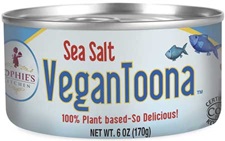 Named after Wang’s daughter, Sophie, who has a shellfish allergy, the company offers Breaded Vegan Crab Cakes, Breaded Vegan Scallops, Breaded Vegan Shrimp, canned Vegan Toona Sea Salt, and several other items. The products are flavored with seaweed “but not in a way to put people off,” Wang maintains.
Named after Wang’s daughter, Sophie, who has a shellfish allergy, the company offers Breaded Vegan Crab Cakes, Breaded Vegan Scallops, Breaded Vegan Shrimp, canned Vegan Toona Sea Salt, and several other items. The products are flavored with seaweed “but not in a way to put people off,” Wang maintains.
Another product that has captured Nielsen’s attention is a vegan mayonnaise manufactured by Sir Kensington’s, a New York City–based condiment company. As a replacement for eggs, Fabanaise uses aquafaba, the normally discarded water used in the cooking of chickpeas.
Scott Norton, Sir Kensington’s cofounder, explains that he wanted to develop a mayonnaise alternative with a richer flavor and texture than the typical vegan mayos on the market, which are mostly made with processed soy protein and pea protein. After learning on the Internet that a number of vegan chefs use aquafaba as a replacement for egg whites in meringues, the company decided to explore chickpea water’s potential application as a mayonnaise emulsifier.
“After a lot of testing, we discovered that it works phenomenally well to make an eggless mayo,” Norton says. “In addition to aquafaba, we add a kombu seaweed, which is a natural source of savory flavor.”
Sir Kensington’s sources its aquafaba from a hummus company “that had been pouring thousands of pounds of aquafaba down the drain every year,” Norton notes. “We worked with this company to create the world’s first food-safe supply chain for rescuing and repurposing aquafaba, turning it from food waste into an ingredient of real benefit.”
In the realm of dairy substitutes, “the vegan cheese space has been especially exciting,” Nielsen says.
Daiya Foods in Vancouver, British Columbia, for one, does an excellent job of replicating mainstream cheese varieties, she points out. Using 30 dairy alternative ingredients, the company makes a wide range of products, including sliced Swiss-style, cheddar-style, and provolone-style vegan cheese; mozzarella-, cheddar- and pepper jack–style shreds; several vegan block cheeses; and vegan Greek yogurt, cream cheese, and cheesecake alternatives.
Kite Hill, Hayward, Calif., which makes almond-based yogurts, cream cheese, and artisanal cheese alternatives, has received $18 million in funding from General Mills’ 301 Inc., CAVU Venture Partners, and other investors.
Although Miyoko’s Kitchen is known mostly for its artisanal vegan cheeses such as Classic Double Cream Chive and Double Cream Sundried Tomato Garlic (made from organic cashews, coconut oil, and chickpea miso), Schinner also makes a Vegan Mozz mozzarella substitute for pizza and European Style Cultured VeganButter. She notes that her firm is always experimenting with new ingredients, including those inspired by her Japanese heritage, to create unique flavors and textures that don’t just mimic traditional dairy products.
Plants for Their Own Sake
Many companies that have introduced new vegan or vegetarian items are celebrating the natural flavors of plant-based foods in their own right.
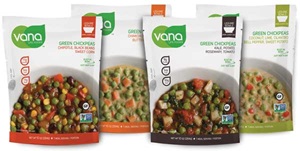 Products made from chickpeas, lentils, and other pulses commanded more attention in 2016, which the United Nations Food and Agricultural Organization designated the Year of the Pulse. One start-up, Seattle-based Vana Life Foods, debuted its Green Chickpea Superfood—a shelf-stable meal packaged in a microwavable pouch that converts into a bowl.
Products made from chickpeas, lentils, and other pulses commanded more attention in 2016, which the United Nations Food and Agricultural Organization designated the Year of the Pulse. One start-up, Seattle-based Vana Life Foods, debuted its Green Chickpea Superfood—a shelf-stable meal packaged in a microwavable pouch that converts into a bowl.
“Green chickpeas are young chickpeas that are harvested about a month earlier than blonde chickpeas,” explains Krishan Walia, the company’s founder and CEO. “We use a patented technology that is proprietary to us and our main grower.” Walia adds that because green chickpeas are harvested earlier, they are higher in protein, vitamins, and minerals and lower in carbohydrates and starches than blonde chickpeas.
With 11 grams of protein per serving, the Vana Life green chickpea meals come in four varieties that prominently list their ingredients: chipotle, black beans, and sweet corn; chimichurri, coconut, and butternut squash; kale, potato, rosemary, and tomato; and coconut, lime, cilantro, bell pepper, and sweet potato.
In the snack food domain, Fairfax, Va.–based TaDah Foods now offers a line of Falafel Poppers that is “delightful and delicious” in Nielsen’s opinion. The chickpea fritters, which are filled with hummus, are available in three flavors: Cucumber Dill Yogurt, Harissa Hummus, and Lemony Roasted Garlic Hummus.
Minneapolis-based General Mills, in turn, not only is investing in plant-based food start-ups, but also its Progresso brand has rolled out a line of vegan soups called Good Natured. “We were seeing that people were searching for convenient ways to eat healthy, satisfying meals,” notes Roger Galloway, senior marketing manager for Progresso. “We also saw trends that support the importance of plant-based diets.”
The vegan soup category has been expanding rapidly. “According to a report by Innova Market Insights, between 2011 and 2015 the number of new soup items launched that are vegan nearly doubled, equating to a compound annual growth rate of 14%,” Galloway shares. “We’re really carving out a niche in this category, which has a lot of momentum.”
The Good Natured soups, which come in cartons rather than cans, include three varie-ties so far: Hearty Lentil with Garden Vegetables, Hearty Corn and Chipotle Chowder, and Hearty Tomato with Spinach and Roasted Garlic.
Petaluma, Calif.-based Amy’s Kitchen, known mainly for its vegan frozen meals, has also introduced several vegan soups, including Organic Tuscan Bean & Rice, Organic Lentil Vegetable, Organic Vegetable Barley, and Organic Quinoa, Kale & Red Lentil.
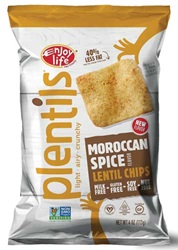 Owned by Mondelez International, Chicago-based Enjoy Life Foods actively looks for ways to incorporate plant-based ingredients in it products, according to Joel Warady, the company’s chief of marketing. For example, Enjoy Life manufactures a line of vegan lentil chips called Plentils, available in five flavors: Original Sea Salt, Dill & Sour Cream, Margherita Pizza, Garlic & Parmesan, and Moroccan Spice.
Owned by Mondelez International, Chicago-based Enjoy Life Foods actively looks for ways to incorporate plant-based ingredients in it products, according to Joel Warady, the company’s chief of marketing. For example, Enjoy Life manufactures a line of vegan lentil chips called Plentils, available in five flavors: Original Sea Salt, Dill & Sour Cream, Margherita Pizza, Garlic & Parmesan, and Moroccan Spice.
In addition, the company just rolled out a new product, ProBurst Bites, which Warady describes as “a plant-based, truffle-like protein ball that is made using our soy-free, dairy-free chocolate, with seeds as well as brown rice added to provide some extra protein.” Four items, each with 6 or 7 grams of protein per serving, make up this line: Cinnamon Spice, Mango Habanero, Cranberry Orange, and Sunseed Butter.
One reason more people are avoiding dairy food today is that “dairy products have a negative impact on the gut,” Warady contends. “We think gut health will be the next big area of focus for the food industry.”
Consequently, Enjoy Life Foods adds probiotics as well as algae protein—an emerging vegan trend—to its muffin mix and brownie mix. “Algae protein is an ingredient that we like, and we’re looking to see how we might incorporate it into some other products,” Warady says.
Food scientists are still experimenting with how to best source and use algae. One company, Keego Harbor, Mich.–based ZIVO Biosciences, has developed a proprietary algae culture that will soon be introduced to the market. “It’s a fresh-water green filamentous algae that is a macro-algae rather than a micro-algae,” says ZIVO President and CEO Andrew A. Dahl. “Our algae is easier to harvest and process than some other forms of algae just because of its physical handling characteristics.”
Dahl says his firm’s algae is 42% protein, 24% fiber, and 8% fat. “We also have in 3 ounces of algae more vitamin C than a medium-sized orange,” he adds.
A key reason to invest in algae is that it promotes environmental sustainability, according to Dahl. “We use only 10% of the fossil fuel and 10% of the water that is used to grow corn or soybeans on the same amount of land,” he explains. “An acre of soybeans produces approximately 55 bushels of soy. We produce five times that much protein on the same acreage.”
Looking Ahead but How Far?
Although mostly flexitarians consume vegan products today, Schinner believes that eventually plant-based agriculture will supplant animal-based agriculture—as more people and institutions recognize that this dramatic shift would enhance the well-being of humans, animals, and the planet.
Schinner points out that a number of farmers, ranchers, and meat processing companies have already transitioned their businesses away from animal-based food production, citing as examples The Sanctuary at Soledad Goats, a goat sanctuary and vegan cheesemaker in Mojave, Calif., and Rowdy Girl Sanctuary, where a former rancher and his wife care for rescued cattle, pigs, chickens, and turkeys in Angleton, Texas.
In addition, Rügenwalder Mühle, a large meat processing company in Germany, now makes mostly vegetarian sausages. Its director, Christian Rauffus, reportedly once commented to the German press that sausage could become the “cigarette of the future” (Schoon 2015).
Schinner realizes that it will take considerable time for such business transformations to become commonplace. But she notes that FAIRR and other investment organizations have an enormous amount of money available to help promising plant-based food companies get off the ground.
“There is so much money out there,” Schinner says. “So if we can get people who are involved in animal agriculture to understand that the future is not in what they’re doing but in plant-based food—and we help them transition—then maybe we can make that revolution happen a little faster.”
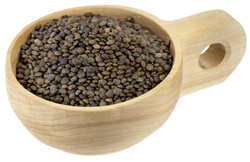 New Plant Proteins Take Root
New Plant Proteins Take Root
In a world where soy has long been the protein of choice for many vegetarian and vegan dishes, there are newcomers to the scene. These five plant-based protein options are impacting the culinary landscape, and for good reason.
• Proprietary Protein Blend. The idea for PROFI originated in response to the growing demand for a nutritious substitute combining a dietary fiber with a high-protein, plant-based composite containing all nine essential amino acids.
Now it’s a proprietary blend of pea protein, brown rice protein, lentil protein, and chickpea powder and is designed to replace soy, dairy, and meat as a high-protein, low-calorie alternative (about 20 g of protein per 120 calories).
“PROFI was specifically designed to have a neutral taste, light ivory color, and to blend well in both water- and oil-based food systems,” says Debra Tomotsugu, manager, marketing and sales support at Dealers Ingredients, Brampton, Ontario, Canada.
Over the years, the Dealers Ingredients team learned the best combinations of proteins to yield complete protein composition, leading them to PROFI Pro and PROFI Bake.
“PROFI Bake is especially designed to manage water like flour [does],” says Tomotsugu. “So, it can replace flour on a one-to-one basis in most recipes.”
• Pulses. Pulse flours derive from peas, lentils, and faba beans, with a protein concentration of 55%, 55%, and 60%, respectively.
“We have seen interest in vegetable-based ingredients skyrocketing with one in three consumers stating that they prefer a vegetable-sourced protein to an animal-sourced protein,” says Pat O’Brien, manager, strategic business development at Ingredion.
The natural flavor profile of pulse is beany, but for those interested in a blander flavor profile, Ingredion, Westchester, Ill., and AGT Foods, Regina, Saskatchewan, Canada, launched clean-taste pulse ingredients for easier integration across applications. In addition to baked goods, soups, and batters, pulse protein is being used in vegan cheese formulations for both nutritional and textural purposes.
• Algae. Algae might be one of—if not the—oldest plants on earth. But algae is being used in a very new way.
According to Mark Brooks, senior vice president of food ingredients, San Francisco-based TerraVia has spent more than a decade researching over 100,000 microalgae strains to find optimal ones for food ingredients. An advantage of algae, says Brooks, is its limited interaction with other ingredients.
“When used in formulations, the protein and nutrients are protected by the algae cell wall,” says Brooks. “This protection enables fortification in challenging applications such as low pH beverages, doughs, smooth dressings, and low-moisture products like crackers—and with no impact on viscosity at up to 20% inclusion.”
Used in vegetarian and vegan products like cereals, bakery mixes, and beverages, algae is well positioned to continue making an impact on the culinary world.
• Lenteins. While not yet commercialized, lenteins, also known as “water lentils,” have “been around for hundreds of years and have the best amino acid profiles of all plant-based proteins, including soy,” says Cecilia Wittbjer, marketing manager at Parabel, Fellsmere, Fla.
Derived from the plant Lemnoideae, lenteins are able to double in biomass every day, and Parabel has plants in Florida that are yielding high volumes of these nonallergenic leaf proteins.
Rich with vitamins, minerals, and protein and similar to whey in amino acid profile, lenteins have a number of applications, including smoothies, soups, pastas, and baked goods. “It’s extremely adaptable,” Wittbjer says. “For example, some markets are looking to use lentein instead of greens in matcha tea.” Parabel’s lentein protein is set for a debut early this year.
• Hemp. Alan Rillorta, director of protein and branded ingredient sales at AIDP, City of Industry, Calif., describes hemp as a “super plant.” “Not only can we use its protein, but other parts of hemp, such as the fiber, oil, etc., are highly desirable for use in making building materials, textiles, foodstuffs, and even biodiesel.”
AIDP’s hemp proteins have a nutty flavor, a white color, and a smooth mouthfeel, and their primary application is in protein powder shakes. Rillorta said that while there are some limitations on hemp—notably hemp farming and “some stigmas”—many formulators are using hemp due to its high marketability. Hemp is an eco-friendly, nutrition-rich plant protein whose sustainability and adaptability make it a viable new ingredient option.
Scott Frankel is a freelance writer based in the Chicago area ([email protected]).
Carolyn Doris is a freelance writer based in the Chicago area ([email protected]).
Latest News

Vickie Kloeris Shares NASA Experiences in New Book, Consumers Are Confused About Processed Foods’ Definition
Innovations, research, and insights in food science, product development, and consumer trends.

Top 10 Functional Food Trends: Reinventing Wellness
Consumer health challenges, mounting interest in food as medicine, and the blurring line between foods and supplements will spawn functional food and beverage opportunities.

Better-for-you products on display at Natural Products Expo West
A photo overview of products shared at the 2024 Natural Products Expo West in Anaheim, Calif.

Adapting to Change: Insights From the RCA Conference
An overview of insights shared at the Research Chefs Association (RCA) Annual Conference & Culinology Expo in Quincy, Mass.

True Colors
A visually oriented overview of food color and colorant ingredient trends.





